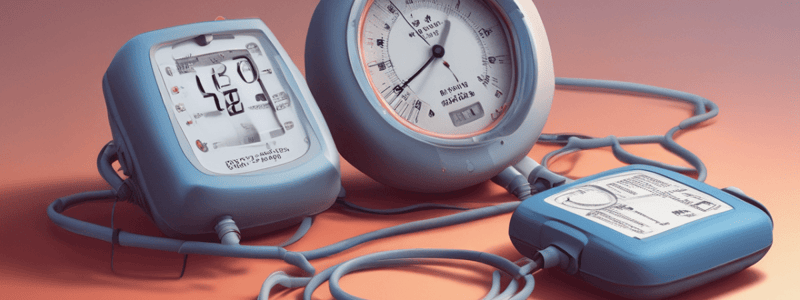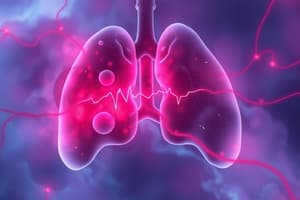Podcast
Questions and Answers
What is a characteristic of the indirect palpation technique?
What is a characteristic of the indirect palpation technique?
- It is used to measure blood pressure in patients with hypertension
- It is used to measure blood pressure in patients with severe blood loss
- It is used to measure blood pressure in patients with normal blood pressure
- It is useful for patients whose arterial pulsations are too weak to create Korotkoff sounds (correct)
What is the Auscultatory Gap?
What is the Auscultatory Gap?
- The difference between the blood pressure in the upper and lower extremities
- The distance between the systolic and diastolic blood pressure
- The temporary disappearance of sounds usually heard over the brachial artery when the cuff pressure is high (correct)
- The range of pressures in which Korotkoff sounds can be heard
Why is palpation technique difficult to assess in diastolic pressure?
Why is palpation technique difficult to assess in diastolic pressure?
- Because the arterial pulsations are too strong
- Because it is difficult to hear Korotkoff sounds
- Because the systolic pressure is always higher than the diastolic pressure
- Because the diastolic pressure is difficult to assess by palpation (correct)
What is the site for auscultation in lower extremity blood pressure measurement?
What is the site for auscultation in lower extremity blood pressure measurement?
What is a benefit of using automated blood pressure measurement?
What is a benefit of using automated blood pressure measurement?
What is an advantage of self-measurement of blood pressure?
What is an advantage of self-measurement of blood pressure?
What is an example of a nursing diagnosis related to blood pressure?
What is an example of a nursing diagnosis related to blood pressure?
What is a related factor that may lead to a diagnosis of decreased cardiac output?
What is a related factor that may lead to a diagnosis of decreased cardiac output?
What is a characteristic of blood pressure in the legs compared to the brachial artery?
What is a characteristic of blood pressure in the legs compared to the brachial artery?
Why is it recommended to use automated blood pressure measurement over manual measurement?
Why is it recommended to use automated blood pressure measurement over manual measurement?
What is the main reason why the nurse may need to use the palpation technique to measure blood pressure?
What is the main reason why the nurse may need to use the palpation technique to measure blood pressure?
When using the palpation technique, which of the following is true?
When using the palpation technique, which of the following is true?
What is the significance of the auscultatory gap in blood pressure measurement?
What is the significance of the auscultatory gap in blood pressure measurement?
When measuring blood pressure in the lower extremity, where should the cuff be positioned?
When measuring blood pressure in the lower extremity, where should the cuff be positioned?
What is the advantage of using automatic blood pressure devices over manual measurement?
What is the advantage of using automatic blood pressure devices over manual measurement?
What is the benefit of self-measurement of blood pressure?
What is the benefit of self-measurement of blood pressure?
What is the relationship between blood pressure in the legs and the brachial artery?
What is the relationship between blood pressure in the legs and the brachial artery?
What is the role of blood pressure measurement in the nursing process?
What is the role of blood pressure measurement in the nursing process?
What is the purpose of assessing blood pressure and pulse in the nursing process?
What is the purpose of assessing blood pressure and pulse in the nursing process?
What is the role of the nurse in relation to blood pressure measurement?
What is the role of the nurse in relation to blood pressure measurement?
Flashcards are hidden until you start studying
Study Notes
Blood Pressure
- Blood pressure is the force exerted on the walls of an artery by the pulsing blood under pressure from the heart.
- Blood flow throughout the circulatory system, moving from an area of high to an area of low pressure.
- Systematic or arterial blood pressure is a good indicator of cardiovascular health.
Components of Blood Pressure
- Systolic blood pressure: the peak maximum pressure when the heart ventricles contract.
- Diastolic blood pressure: the pressure when the heart ventricles relax.
- Pulse pressure: the difference between systolic and diastolic pressure.
Physiology of Arterial Blood Pressure
- Blood pressure reflects the interrelationships of cardiac output, peripheral vascular resistance, blood volume, blood viscosity, and artery elasticity.
- Hemodynamic variables:
- Cardiac output: increases blood pressure as it increases.
- Peripheral vascular resistance: increases blood pressure as it increases.
- Blood volume: increases blood pressure as it increases.
- Blood viscosity: increases blood pressure as it increases.
- Artery elasticity: decreases blood pressure as it decreases.
Factors Influencing Blood Pressure
- Age:
- Blood pressure increases during childhood.
- Blood pressure tends to increase with advancing age.
- Stress:
- Emotional stress increases heart rate, cardiac output, blood pressure, and peripheral vascular resistance.
- Gender:
- Males tend to have higher blood pressure after puberty.
- Females are at increased risk for hypertension due to changes like pregnancy, birth control, and menopause.
- Daily variation:
- Blood pressure increases in the morning, peaks in the late afternoon, and decreases at night.
- Medications:
- Certain medications can affect blood pressure.
- Activity, weight, and smoking:
- Blood pressure can be reduced for several hours after exercise.
- Obesity is a factor in hypertension.
- Blood pressure rises when smoking and returns to baseline 15 minutes after smoking ceases.
Hypertension
- Defined as a blood pressure of 140/90 mmHg or higher.
- Often asymptomatic.
- Associated with thickening and loss of elasticity in the arterial walls.
- Diagnosed using criteria:
- Mean blood pressure obtained by office blood pressure measurement or automated office blood pressure.
- First reading of systolic blood pressure measured by automated office blood pressure.
- Systolic blood pressure measured by office blood pressure measurement.
Hypotension
- Defined as a systolic blood pressure of 90 mmHg or lower.
- Occurs due to the dilation of arteries, loss of blood volume, or failure of the heart muscle to pump adequately.
- Associated with pallor, skin mottling, clamminess, confusion, increased heart rate, or decreased urine output.
Measuring Blood Pressure
- Can be measured directly (invasively) or indirectly (noninvasively).
- Indirect measurement:
- Uses a sphygmomanometer and stethoscope.
- Cuff should be proportional to the circumference of the limb being assessed.
- Lower edge of the cuff should be positioned 3 cm above the antecubital fossa.
Oscillometric and Auscultation Methods
- Oscillometric method:
- Uses a sphygmomanometer and electronic device to detect blood pressure.
- Preferred over auscultation method.
- Auscultation method:
- Uses a stethoscope to detect Korotkoff sounds.
- Best environment for measurement is a quiet room at a comfortable temperature.
Orthostatic Hypotension
- Defined as a drop in blood pressure when standing up from a sitting or lying down position.
- Caused by the dilation of arteries in the vascular bed, loss of blood volume, or failure of the heart muscle to pump adequately.
- Associated with pallor, skin mottling, clamminess, confusion, increased heart rate, or decreased urine output.
Blood Pressure in Children
- Changes with growth and development.
- Measurement of blood pressure in infants and children is difficult due to:
- Difficulty in obtaining cooperation.
- Placing the stethoscope too firmly on the antecubital fossa.
- Korotkoff sounds are difficult to hear in children.
Nursing Process and Vital Signs
- Assessing blood pressure and pulse evaluates the patient's general state of cardiovascular health and responses to other system imbalances.
- Hypotension, hypertension, orthostatic hypotension, and narrow or wide pulse pressures are defining characteristics of certain nursing diagnoses.
Blood Pressure
- Blood pressure is the force exerted on the walls of an artery by the pulsing blood under pressure from the heart.
- Blood flow throughout the circulatory system, moving from an area of high to an area of low pressure.
- Systematic or arterial blood pressure is a good indicator of cardiovascular health.
Components of Blood Pressure
- Systolic blood pressure: the peak maximum pressure when the heart ventricles contract.
- Diastolic blood pressure: the pressure when the heart ventricles relax.
- Pulse pressure: the difference between systolic and diastolic pressure.
Physiology of Arterial Blood Pressure
- Blood pressure reflects the interrelationships of cardiac output, peripheral vascular resistance, blood volume, blood viscosity, and artery elasticity.
- Hemodynamic variables:
- Cardiac output: increases blood pressure as it increases.
- Peripheral vascular resistance: increases blood pressure as it increases.
- Blood volume: increases blood pressure as it increases.
- Blood viscosity: increases blood pressure as it increases.
- Artery elasticity: decreases blood pressure as it decreases.
Factors Influencing Blood Pressure
- Age:
- Blood pressure increases during childhood.
- Blood pressure tends to increase with advancing age.
- Stress:
- Emotional stress increases heart rate, cardiac output, blood pressure, and peripheral vascular resistance.
- Gender:
- Males tend to have higher blood pressure after puberty.
- Females are at increased risk for hypertension due to changes like pregnancy, birth control, and menopause.
- Daily variation:
- Blood pressure increases in the morning, peaks in the late afternoon, and decreases at night.
- Medications:
- Certain medications can affect blood pressure.
- Activity, weight, and smoking:
- Blood pressure can be reduced for several hours after exercise.
- Obesity is a factor in hypertension.
- Blood pressure rises when smoking and returns to baseline 15 minutes after smoking ceases.
Hypertension
- Defined as a blood pressure of 140/90 mmHg or higher.
- Often asymptomatic.
- Associated with thickening and loss of elasticity in the arterial walls.
- Diagnosed using criteria:
- Mean blood pressure obtained by office blood pressure measurement or automated office blood pressure.
- First reading of systolic blood pressure measured by automated office blood pressure.
- Systolic blood pressure measured by office blood pressure measurement.
Hypotension
- Defined as a systolic blood pressure of 90 mmHg or lower.
- Occurs due to the dilation of arteries, loss of blood volume, or failure of the heart muscle to pump adequately.
- Associated with pallor, skin mottling, clamminess, confusion, increased heart rate, or decreased urine output.
Measuring Blood Pressure
- Can be measured directly (invasively) or indirectly (noninvasively).
- Indirect measurement:
- Uses a sphygmomanometer and stethoscope.
- Cuff should be proportional to the circumference of the limb being assessed.
- Lower edge of the cuff should be positioned 3 cm above the antecubital fossa.
Oscillometric and Auscultation Methods
- Oscillometric method:
- Uses a sphygmomanometer and electronic device to detect blood pressure.
- Preferred over auscultation method.
- Auscultation method:
- Uses a stethoscope to detect Korotkoff sounds.
- Best environment for measurement is a quiet room at a comfortable temperature.
Orthostatic Hypotension
- Defined as a drop in blood pressure when standing up from a sitting or lying down position.
- Caused by the dilation of arteries in the vascular bed, loss of blood volume, or failure of the heart muscle to pump adequately.
- Associated with pallor, skin mottling, clamminess, confusion, increased heart rate, or decreased urine output.
Blood Pressure in Children
- Changes with growth and development.
- Measurement of blood pressure in infants and children is difficult due to:
- Difficulty in obtaining cooperation.
- Placing the stethoscope too firmly on the antecubital fossa.
- Korotkoff sounds are difficult to hear in children.
Nursing Process and Vital Signs
- Assessing blood pressure and pulse evaluates the patient's general state of cardiovascular health and responses to other system imbalances.
- Hypotension, hypertension, orthostatic hypotension, and narrow or wide pulse pressures are defining characteristics of certain nursing diagnoses.
Studying That Suits You
Use AI to generate personalized quizzes and flashcards to suit your learning preferences.




